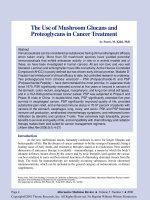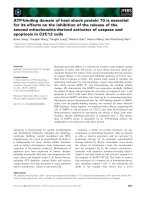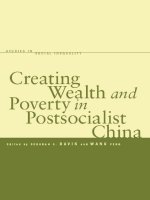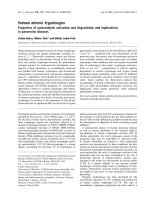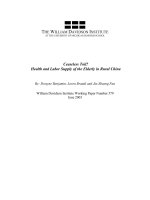Creating wealth and poverty in postsocialist china potx
Bạn đang xem bản rút gọn của tài liệu. Xem và tải ngay bản đầy đủ của tài liệu tại đây (1.52 MB, 314 trang )
creating wealth and poverty
in postsocialist china
w o m e n ’ s w o r k i n g l i v e s i n e a s t
asia
editors
David B. Grusky, stanford university
Paula England, stanford university
editorial board
Hans-Peter Blossfeld
Mary C. Brinton
Thomas DiPrete
Michael Hout
Andrew Walder
Mary Waters
s t u d i e s in
s o c i a l
i n e q u a l i t y
creating wealth and
poverty in postsocialist china
Edited by Deborah S. Davis and Wang Feng
stanford university press
stanford, california
Stanford University Press
Stanford, California
© 2009 by the Board of Trustees of the Leland Stanford
Junior University. All rights reserved.
No part of this book may be reproduced or transmitted
in any form or by any means, electronic or mechanical,
including photocopying and recording, or in any
information storage or retrieval system without the prior
written permission of Stanford University Press.
Printed in the United States of America on acid-free,
archival-quality paper
Library of Congress Cataloging-in-Publication Data
Creating wealth and poverty in postsocialist China /
edited by Deborah S. Davis and Wang Feng.
p. cm. — (Studies in social inequality)
Includes bibliographical references and index.
ISBN 978-0-8047-5931-1 (cloth : alk. paper) —
ISBN 978-0-8047-6116-1 (pbk. : alk. paper)
1. Income distribution — China 2. Wealth — China.
3. Poverty — China. 4. Social stratification — China.
I. Davis, Deborah II. Wang, Feng. III. Series.
HC430.I5C73 2009
339.20951—dc22
2009020017
Typeset by Publishers’ Design and Production Services, Inc.
in 10/13 Sabon
v
Illustrations ix
Acknowledgments xi
Contributors xiii
part i Poverty, Wealth, and Stratification:
The Interconnections
chapter one
Poverty and Wealth in Postsocialist China: An Overview 3
Deborah Davis and Wang Feng
chapter two
Market versus Social Benefits: Explaining China’s
Changing Income Inequality 20
Qin Gao and Carl Riskin
chapter three
Market and Gender Pay Equity: Have Chinese Reforms
Narrowed the Gap? 37
Philip N. Cohen and Wang Feng
chapter four
The Labor of Luxury: Gender and Generational
Inequality in a Beijing Hotel 54
Eileen M. Otis
contents
vi Contents
chapter five
The Changing Structure of Employment in Contemporary China 69
Peter Evans and Sarah Staveteig
part ii Postsocialist Power and Property Relations
chapter six
Institutional Basis of Social Stratification in
Transitional China 85
Liu Xin
chapter seven
Rethinking Corporatist Bases of Stratification in Rural China 97
Xueguang Zhou
chapter eight
Creating Wealth: Land Seizure, Local
Government, and Farmers 112
Zhou Feizhou
chapter nine
Resolution Mechanisms for Land Rights Disputes 126
Zhang Jing
part iii Postsocialist Life Chances
chapter ten
Regional Inequality in China: Mortality and Health 143
Yong Cai
chapter eleven
Beyond Cost: Rural Perspectives on Barriers to Education 156
Emily Hannum and Jennifer Adams
chapter twelve
Urban Occupational Mobility and Employment Institutions:
Hierarchy, Market, and Networks in a Mixed System 172
Yanjie Bian
Contents vii
part iv Interpreting Postsocialist Wealth and Poverty
chapter thirteen
The Social Contours of Distributive Injustice Feelings in
Contemporary China 193
Chunping Han and Martin King Whyte
chapter fourteen
From Inequality to Inequity: Popular Conceptions of Social (In)justice
in Beijing 213
Ching Kwan Lee
chapter fifteen
Social Stratification: The Legacy of the Late Imperial Past 232
R. Bin Wong
Reference Matter
Notes 249
References 265
Index 289
ix
illustrations
Figures
3.1 Gender penalty in income, urban China, 1986–2000
(adjusted) 39
3.2 Gender composition and average income, by sector,
occupation, and industry, urban China, 1999 43
3.3 Gender gap in income, by city GDP (empirical Bayes
estimates, with person-level controls) 50
5.1 Economically active population by sector, United
Kingdom, 1800–2004 75
5.2 Economically active population by sector, South Korea,
1960–2004 76
5.3 Economically active population by sector, China,
1952–2002 78
6.1 A framework of class analysis in urban China 94
10.1 Female life expectancies at birth in China, India, and the
United States, selected years 144
10.2 Life expectancy at birth, China, 2000 149
Tables
2.1 Changes in household per capita income and social
benefits in urban China 23
2.2 Urban income inequality and its sources 25
2.3 Changes in household per capita income and social
benefits in rural China 30
2.4 Rural income inequality and its sources 31
2.5 Share of tax payments in total household income by decile
in rural China (%) 33
2.6 Composition and distribution of income of rural migrants
in 2002 34
x Illustrations
3.1
Descriptive statistics, urban household survey, 1999 42
3.2 Effects of gender and other factors on income, urban
China, 1999 (OLS results, Ln income) 44
3.3 Effects of gender on income by sector,
urban China, 1999 47
3.4 Hierarchical linear models for total income (Ln)
on individual and city characteristics 49
8.1 Land conversion income costs and net profit,
J City, Zhejiang Province 116
8.2 Extrabudgetary revenue in three study sites,
Zhejiang Province, 2003 117
8.3 Land revenue’s contribution to local budget revenues
(S County) 117
8.4 Two types of construction use—land conversion,
S County, 1999–2004 118
8.5 Land and resettlement compensation allowance standards
for each township, S County (in yuan) 121
10.1 Variable definition and summary statistics 151
10.2 Spatial conditional autoregressive models predicting
life expectancy at birth, Models 1–3 (N = 2,367) 152
10.3 Spatial conditional autoregressive model predicting
life expectancy at birth, Model 4 (N = 2,367) 153
11.1 Respondent reports of factors contributing to
non-enrollment, 2004 (N = 1,817) 161
11.2 Enrollment in rates 2004 by hypothesized barriers
to enrollment (N = 1,817) 165
11.3 Barriers to enrollment 2004 166
12.1 Descriptive information of the 2003 CGSS sample:
Relevant variables 173
12.2 Rates of job change and age structure by year,
2003 CGSS (urban) percentages 175
12.3 Search channel by period, 2003 CGSS (urban) 178
12.4 Logistic regression on the use of search channel
that delivers a job 183
12.5 Multinomial regression on the effects of search channels
and network resources on up/downward mobility
(Exp B presented) 186
13.1 Responses to selected inequality and distributive justice
questions (weighted distributions, row percentages) 201
13.2 Predictors of distributive injustice feelings
(bivariate correlations and unstandardized
regression coefficients) 203
xi
acknowledgments
As this project moved from a conference at Yale University to published
book, we have benefited from the intellectual encouragement of many col-
leagues and financial support of several organizational sponsors. We grate-
fully acknowledge grants from the Center for Asian Studies at the University
of California, Irvine, the Council of East Asian Studies at Yale University,
the Ford Foundation, and the American Sociological Association Fund for
the Advancement of the Discipline that supported the January 6–8, 2006,
conference and an additional publication grant from the Yale Council of
East Asian Studies. We also wish to thank Mimi Yiengpruksawan, then chair
of the Council of East Asian Studies, and staff member Abbey Newman
for their superb logistical support and leadership during our meetings in
New Haven as well as Kate Wahl, our Stanford University Press editor, and
her editorial assistant, Joa Suorez, for their expert guidance at all stages of
manuscript preparation.
During the conference, discussants Dalton Conley, Sarah Cook, Bonnie
Erickson, John Logan, Jesper Sørensen, and Iván Szelényi pushed authors
to place their arguments in broadest comparative perspective, and in the
final stages of manuscript preparation we benefited from critical reading by
Dorothy Sollinger, two anonymous reviewers, and the superb translation
work by Xuan Gui (Chapters 6 and 9) and Laura Burian (Chapter 8). The
final manuscript gained substantively from these intellectual contributions.
Deborah Davis and Wang Feng
January 2008
xiii
contributors
jennifer adams, Assistant Professor, School of Education, Stanford
University
yanjie bian, Professor, Department of Sociology, University of Minnesota,
Chair Professor and the Director of Survey Research Center, Hong Kong
University of Science and Technology
yong cai, Assistant Professor, Department of Sociology, University of Utah
philip n. cohen, Associate Professor, Department of Sociology, Fellow,
Carolina Population Center, University of North Carolina, Chapel Hill
deborah davis, Professor, Department of Sociology, Yale University
peter evans, Eliaser Professor of International Studies and Professor of
Sociology, Department of Sociology, University of California, Berkeley
qin gao, Assistant Professor, Fordham University Graduate School of Social
Service
chunping han, Ph.D. student, Department of Sociology, Harvard University
emily hannum, Associate Professor, Department of Sociology, University
of Pennsylvania
ching kwan lee, Professor, Department of Sociology, University of Califor-
nia, Los Angeles
liu xin, Professor and Chair, Department of Sociology, Fudan University
eileen m. otis, Assistant Professor, Department of Sociology, University of
Oregon
carl riskin, Distinguished Professor of Economics, Department of Eco-
nomics, Queens College, CUNY, and Senior Research Scholar, Weatherhead
East Asian Institute, Columbia University
xiv Contributors
sarah staveteig, Ph.D. student, Departments of Demography and Sociol-
ogy, University of California, Berkeley
wang feng, Professor and Chair, Department of Sociology, University of
California, Irvine
r. bin wong, Director, Asia Institute and Professor of History, University of
California, Los Angeles
martin king whyte, Professor, Department of Sociology, Harvard
University
zhang jing, Professor, Department of Sociology, Peking University
zhou feizhou, Associate Professor, Department of Sociology, Peking
University
xueguang zhou, Professor, Department of Sociology, Stanford University
creating wealth and poverty
in postsocialist china
part i
poverty, wealth,
and stratification:
the interconnections
3
chapter one
Poverty and Wealth in Postsocialist China:
An Overview
Deborah Davis and Wang Feng
China today is an economic giant deeply embedded in global trade and
production. In 2006, China’s nominal gross domestic product (GDP) ex-
ceeded two and one-half trillion U.S. dollars, larger than that of France and
approaching that of Germany. Calibrated in the metric used by the World
Bank to capture comparable real standards of living, China’s GDP in 2006
reached 10.21 trillion purchasing power parity (PPP) dollars, thereby plac-
ing its economy second in the world only after the United States.
1
In the
three decades since 1979, when it began to dismantle the socialist planned
economy, China has become the number one recipient of global capital flow
among all developing countries, and the Shanghai Stock Exchange, which
reopened in 1990, had by 2007 become the sixth largest stock exchange in
the world.
2
In May 2007 eight million new accounts were opened in a single
month. For the first time in its history, the combined stock market capital-
ization in China’s two stock exchanges surpassed its GDP.
3
By any metric
China is a central player in global capitalism, and the practices and institu-
tions of socialism appear to have receded into a distant past.
Communist capitalism has not only produced an economic miracle but
also glaring inequality. In 2005, China Daily reported that 236,000 citizens
were millionaires and that the number of individuals with at least one mil-
lion U.S. dollars in assets grew at the sixth fastest pace in the world (Wilson
2005). At the same time, per capita incomes are low and a majority of citi-
zens live on less than two dollars a day. Moreover, simultaneously with sus-
tained macro level growth, levels of income inequality are now comparable
to those in the United States and greater than those in India and Indonesia.
4
Thus, within the story of global growth and new affluence are social, politi-
cal, and economic dynamics that produce both wealth and poverty.
One can argue that the most central process in China’s postsocialist
transformation is the “reallocation of labor and capital” that transformed
other former socialist economies (Mitra and Yemtsov 2006: 25). Yet in al-
most every parameter China’s postsocialist trajectory does not parallel those
of Russia and Eastern Europe in initial outcomes or pace of change. In-
stead of suffering a devastating economic downturn in its initial retreat from
4 Deborah Davis and Wang Feng
socialist autarky, China experienced two decades of double-digit growth
and a dramatic drop in poverty. In contrast to the “shock therapy” that
characterized postsocialist transformations in Europe and Central Asia,
China followed a gradualist reform approach that not only avoided sudden
economic contraction but also kept the state firmly at the helm. In addition,
even as China has emerged as a giant in the global capitalist economy, the
communist one-party system that engineered both the socialist and the post-
socialist revolutions retains its political monopolies. In 2007, twenty-four
Chinese companies made the list of the Fortune 500;
5
all were either owned
or controlled by the Chinese state. China’s postsocialist economic surge,
therefore, in many ways more closely resembles the trajectory to relative af-
fluence in the 1970s of such authoritarian East Asian developmental states
as Taiwan and Korea rather than duplicating the experience of the former
Soviet Union or Eastern Europe.
Prevailing meta-explanations for rapid transformation typically privi-
lege dichotomized pairs of economic and social stratification regimes, high-
lighting the shift from an agrarian to an industrial society or from a planned
to a market system. But China’s transformation does not accord easily with
either an abrupt transition to an industrial society or sudden abandonment
of a command economy. Central to China’s emerging dynamics of social
stratification is the interaction between institutional practices of the socialist
decades and deep engagement with the market rules of global production.
For example, twenty-five years after the demise of the People’s Communes,
there is still neither private ownership of agricultural land nor total free-
dom to move permanently from a village to the city. Equally important is
the coherence and power of the Chinese Communist Party. In 1991, just
prior to Deng Xiaoping’s intensification of market reforms, the Communist
Party had 51 million members, or 4.4 percent of the entire population; by
2005 membership reached 70.8 million or 5.5 percent of the population
(Xinhua 2006b). Furthermore, although there have been reports of declines
in the number of Young Communist League branches, League membership
remains an essential stepping-stone for career advancement, and recruitment
efforts have recently intensified on university campuses (Rosen 2004).
6
No
one would dispute that the Chinese economy has “grown out of the (social-
ist) plan” (Naughton 1995), but it is equally true that the party organiza-
tions and officials close to party-state power continue to hoard income-
generating opportunities and extract major rents. Extensive expropriation
of collectively owned agricultural land for state infrastructure projects and
commercial real estate development have created vast profits for officials
and place party-state agents at the center of profit seeking. Consequently,
to understand the current distributions of poverty and wealth as well as
Poverty and Wealth in Postsocialist China 5
the underlying processes that stratify Chinese society, we emphasize institu-
tional context and historical legacies.
For example, to understand the situation of industrial workers in a post-
socialist China, we must consider China’s long history of sustained invest-
ment in industry. From the very first years after the establishment of the Peo-
ple’s Republic in 1949, the Chinese Communist Party (CCP) leadership was
committed to rapid industrialization. Thus, the industrial capitalist practices
in recent decades have evolved both from three decades of Soviet style ur-
ban industrialization and the evolution of rural township-village-enterprises
(TVEs), whose origins are in part in the five small industries sponsored by
the People’s Communes when subcontracting to urban state-owned enter-
prises (SOEs). The current receptivity to global investment in Chinese in-
dustry and massive spending on industrial infrastructure, therefore, do not
represent a new commitment to either manufacturing or industrial organiza-
tion.
7
Rather, the most distinctive shift in industrial institutions since 1980
has been a radical spatial redistribution of industrial labor from north to
south and from large cities to an industrializing countryside.
Contributors to this volume address many different dimensions of in-
equality as well as the institutional processes that have generated wealth
for a minority and kept others mired in poverty. The specific location or
population varies by chapter, but each author goes beyond arguments about
efficiencies of marketization and lowered transaction costs to analysis within
a particular institutional and historical context. Cai (Chapter 10), for ex-
ample, explores how recommodification and privatization of social welfare
goods such as medicine have improved quality of services but increased the
risk that illness will push a family into poverty. Xueguang Zhou (Chapter 7)
and Zhou Feizhou (Chapter 8) examine how recommodification of land re-
mains a highly politicized process that creates pockets of great wealth amidst
relative poverty. Zhang Jing (Chapter 9), Han and Whyte (Chapter 13) and
Ching Kwan Lee (Chapter 14) analyze popular understandings of equity and
justice and ask how the legacy of socialist practices creates patterns of in-
equality that differ from those in capitalist societies without a socialist past.
Most broadly, the authors ask how generic capitalist institutions and prac-
tices interact with China’s historical, political, and cultural institutions to
allocate life chances. Like Gerber (2006) in his work on postsocialist Russia,
we offer no overarching explanation. Rather we find that it is the social and
political context and the interaction of individual attributes within particular
organizational settings that define current patterns of social stratification.
In this overview essay we first summarize the distributional outcomes in
terms of income inequality, poverty, and wealth, and then look in more detail
at the configurations of political and economic power that have increased
6 Deborah Davis and Wang Feng
returns on political power and such capital assets as farm land but depressed
returns to manual labor in the service sector and manufacturing.
inequality
In the case of Taiwan and Korea, two early Asian “tigers” who leapt ahead
of their neighbors economically through export-led industrialization, macro-
level economic gains initially left almost no poor household worse off than
before and even reduced income inequality among households (Fei, Ranis,
and Kuo 1979). In high-growth, postsocialist China, however, greater af-
fluence has dramatically reduced the incidence of subsistence poverty but
increased income inequality, resulting in a pattern of rising inequality similar
to that found in Brazil, Mexico, and Indonesia.
8
Prior to market reforms, China had a distinctive pattern of inequality
because of a rural-urban divide that essentially created two forms of social-
ism within one country (Davis 1995 and Whyte 1996). In towns and cities
the socialist revolution created historically unprecedented security as well as
an industrial proletariat whose standard of living approached that of man-
agers and professionals. During the 1970s, average city incomes were triple
those in the countryside and urban income inequality was one of the lowest
in the world (Davis 2000; Parish 1984; Walder 1986; Wang 2008).
Rural residents, however, gained meager rewards from the socialist
revolution. Regardless of whether they grew grain or nongrain crops, farm-
ers could only sell to the government procurement stations at prices fixed
by central ministries to provide cheap food in the cities. Prohibited from
engaging in private trade or handicraft production and denied the oppor-
tunity to leave farming for industrial work, those working in rural areas
were necessarily condemned to the lowest income strata. Only the small
minority who held administrative or professional jobs at the commune level
had access to cash salaries that approached those of the lowest-paid urban
factory workers. The collectivization of rural land during the 1950s had
reduced within-village inequalities. However, because the Maoist blueprint
for the rural sector eliminated self-employment, artisan sidelines, and petty
trade, the same policies that leveled income differences also institutional-
ized village self-sufficiency, which over time created inequalities between vil-
lages that were as great as—if not greater than—those of the precommunist
years. Thus, in one of the ironies of history, the communist victors of the
1946–1949 civil war not only built a collective economy with an unusually
harsh rural-urban divide but also decimated one of the most commodified
and commercialized preindustrial economies in human history (see Chapter
15 by Wong as well as Hamilton 2006; Naquin and Rawski 1987; Pomeranz
2000; Wong 1997) and transformed tens of millions of rural craftsmen and
Poverty and Wealth in Postsocialist China 7
traders into land-bound peasants (Davis 1995; Friedman, Pickowicz, and
Selden 1991, 2005; Knight and Song 1999; Oi 1989; Watson 1984).
Reliance on export-led industrialization and recommodification of
goods and services after the elimination of the People’s Communes radically
altered the earlier socialist rules of the game for rural residents. Households
no longer pooled labor, and by 1993 grain sales and decisions on cropping
were left almost entirely in the hands of individual farmers. As early as 1980,
the government encouraged rural households to start family enterprises and
become individual entrepreneurs and traders. Even as a system of household
registration continues to restrict full access to urban services and permanent
registration, rural labor now flows to city jobs in response to market signals.
As a result, although village incomes still lag behind those in cities, real per
capita incomes rose nearly six-fold between 1978 and 2004. Simultaneously,
however, income inequality at the national level and between rural house-
holds is higher than it was during the socialist decades.
In cities, there was neither a single institutional “big bang” comparable
to the rapid dismantling of the People’s Communes nor as rapid an inflow
to self-employment and private sector employment. However, by the time
China had entered the WTO in 2001, urban labor markets resembled those
in other capitalist economies, and the compressed urban wage structure of
earlier decades had disappeared. In 1988 the Gini coefficient for urban fam-
ily income was 0.227; in 1995 it reached 0.336 and by 2002 had risen to
0.345. See Chapter 2 for a discussion of how inclusion of cash value of
benefits increases the gap.
Rising inequality in China cannot be divorced from the international
political economy within which China has engineered its impressive eco-
nomic growth. China’s economic growth both fueled and has been fueled
by the most recent expansion of global capitalism. Increasingly engaged in
global manufacturing and trade, both state and nonstate employers maxi-
mize their comparative advantage of cheap manual labor. The decision to
enter the WTO and adopt an export-led growth strategy recalibrated the
reward structure across sectors. Particularly in manufacturing enterprises
that had previously operated under soft budget constraints, international
competition pushed managers to widen the potential labor pool and adopt
new criteria for setting wages. Multinationals—first from Taiwan and Hong
Kong; later from Japan, Korea, the United States, and Europe—moved pro-
duction to greenfield sites in southern provinces that had had little or no
industry. Their new shop-floor employees were millions of young rural mi-
grants, not established industrial workers. Initially wages exceeded those in
farming but were lower than those paid in the state manufacturing sector.
By the late 1990s, a national labor market for unskilled and semiskilled
labor had emerged, and wages for manual jobs began to converge across
8 Deborah Davis and Wang Feng
ownership sectors and geographic regions. By contrast, credentialed profes-
sionals and experienced managers who were in short supply commanded a
premium and the blue-collar–white-collar income gap that had been trivial
in socialist cities rapidly increased (Research Group for Social Structure in
Contemporary China 2005).
Macrolevel growth and rising profits over the 1990s, however, did not
greatly increase the percentage of jobs in manufacturing or consistently raise
the wages of industrial labor. On the contrary, the percentage of the labor
force working in manufacturing declined after 1995, and wages for manual
workers stagnated (Research Group for Social Structure in Contemporary
China 2005). As Peter Evans and Sarah Staveteig explain in Chapter 5, rather
than replicate the English experience, in which manufacturing continued to
absorb excess farm labor for half a century, China has already turned to
capital-intensive manufacturing. Therefore, some have estimated that manu-
facturing is unlikely to ever employ more than 15 percent of the labor force
and that, like developed capitalist economies, China must rely on a hetero-
geneous service sector to provide the bulk of new jobs. Moreover, Evans
and Staveteig predict that these new service jobs will be bifurcated between
knowledge jobs with high incomes for an educated minority and semiskilled
jobs with low rates of return on labor for the majority (see Chapter 5 for a
full discussion). Recent wage disparities by sector and occupation support
such predictions. Between 1986 and 2000, the average wage in mining and
quarrying industries dropped from 16 percent above the national average to
11 percent below, whereas in the real estate sector average wages in 2000 ex-
ceeded the national average by 35 percent, in banking and insurance sector
they exceeded by 44 percent, and in scientific research and technical services
by 45 percent (Wang 2008, Chapter 2).
Nor has the rapidly expanding economy benefited men and women
equally. As Philip Cohen and Wang Feng explain in Chapter 3, male-female
wage gaps have widened as a result of expansion of the market economy
and changes in state policies, with the largest disparities appearing in private
sector jobs in cities with highest incomes and fastest growth rates. In China’s
shrinking public sector, however, state controls continue to equalize income
between men and women.
At the end of their analysis, Cohen and Wang suggest that to identify
the actual mechanisms of segmentation and differentiation that intensify
gender inequalities in market-dominated employment, scholars should look
to the microcontext of specific occupations. In Chapter 4, Eileen Otis does
precisely that by drawing on her ethnography of service workers in one
Beijing luxury hotel to illustrate how the employment practices of post-
socialist workplaces systematically heighten distinctions and disparities of
gender. Thus, like Charles and Grusky (2004), Otis finds that manual jobs

